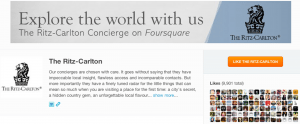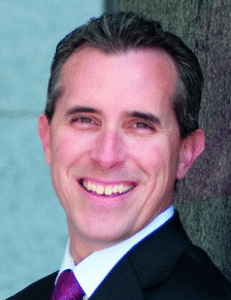Travel is focused on the essence of discovery and experience. Whether you are an intrepid explorer, a parent traveling with your children or a professional traveling on business, The Ritz-Carlton wants to be your definitive guide. When the luxury hotel chain debuted its “Let Us Stay With You” brand platform in the fall of 2011, it was a defining moment for the company.
“Rather than the age-old approach of hotels asking guests to stay with them, our new approach is to let us be the memory you take with you from your travels,” says Allison Sitch, VP of public relations at The Ritz-Carlton. Through the use of artwork, film, messaging and digital platforms, the brand could become much more than just a hotel, but part of a travel experience, Sitch adds.
To take its new brand platform to the next level and educate the road warriors, Ritz-Carlton and its social media agency of record, Pandemic Labs, set out to create the Ritz-Carlton World Concierge on Foursquare.

THE RESERVATION
The World Concierge would communicate with guests through mobile and look to add value to their lives via tips and information on iconic landmarks when they check into Foursquare—even when they’re not staying at a nearby Ritz-Carlton. By providing travelers with compelling information that they may otherwise miss, the hotel sought to make a deeper connection with guests residing at other hotel properties.
The idea leverages Ritz-Carlton’s concierges, who are a source of trusted, insightful and unique information for guests. Until the launch of The Ritz-Carlton World Concierge on Foursquare, the only way to access their expertise was in person.
CHECKING IN
The communications team—which consisted of five communications pros (three from Ritz-Carlton, two from Pandemic)—focused on how to stand out on Foursquare and make news in the space. “We didn’t want what other hotels do and have people check in and see what the soup of the day is,” Sitch says. “We wanted to add value to the consumer experience.”
The PR team came up with the following strategy for the World Concierge initiative:
1. As part of the overarching “Let Us Stay With You” brand platform, all communication channels would be directed towards the brand message. The strategy would extend the expertise of the concierges to cultural attractions, landmarks and other key places in each of its destinations—not just inside their own hotels.
2. Social media would be for guest engagement and add value to the guest experience. “There is zero focus on transactions and business sales,” says Laura Troy, social media manager for The Ritz-Carlton. “We don’t look to social to supplement that in any way. We look to social to deepen our relationship with guests, engage and add value with them and become their trusted resource.”
The concept behind the Foursquare tips is to establish trust in the Ritz-Carlton brand, shying away from sales-speak. “You won’t find any direct sale efforts on any of our social channels,” Troy says.
BRAND PROTECTORS
The Ritz-Carlton arrived slowly in the social space. “We represent a brand that has a $3 billion value that is well-respected and trusted worldwide, and it would be easy for us to dilute that stature,” Sitch says. “We tread very carefully and at all points in our young life in social media we have not once had any pressure to achieve numbers—it’s not the Ritz-Carlton approach.” She adds that the mission is “targeted engagement,” not ROI expectations. “Not everyone can say that—we’re privileged.”
One measurement of social success was consumer and media feedback. “There is no call to action here as a brand—there is no monetary desire for us to have you, the customer, check in at the room in New York. Nothing,” Sitch says.
This concept flies in the face of Foursquare, says Edward Gazarian, account director at Pandemic Labs. “The Ritz-Carlton has a very non-transactional presence, and Foursquare is a point-of-sale mechanism for most brands,” he says.
Pandemic developed a process to collect and organize tips from concierges at The Ritz-Carlton’s 81 hotels worldwide in 27 countries via four main geographic regions. The team worked directly with the concierges from each region, asking them for five to 10 non-branded recommendations for people to visit, and why. It then copy edited the material to reflect a single, authoritative source for unique travel insights.
CATERING FOR THE CONCIERGES
For Gazarian, the most challenging aspect of the effort was to educate concierges on the World-Concierge concept. “Typically when you go to a concierge you will ask for a recommendation for dinner or theatre, but we’re not aiming at anything transactional,” Gazarian says. “We want points of interest, national wonders, museums, art galleries and cultural attractions.”
Helping concierges understand how Foursquare works was another challenge. “If we’ve got a tip on the Metropolitan Museum of Art in New York, the person has to be standing there, checking-in to see it,” Gazarian says. “People aren’t doing this in advance—it’s got to be the site-specific things for where they already are and can capitalize on.”
With the initiative set to launch June 27, 2011, The Ritz-Carlton turned to a targeted list of media that covered the brand in the past, including digital sources like Mashable and AOL’s travel blog Gadling.
EXTERNAL TIPS
Ritz-Carlton’s own property-based tips, which tells on-site guests what people should see, do and experience at the hotels, is driven by Foursquare’s Local Updates tool. “But even those tips add value, because it’s information guests won’t be able to find on ritzcarlton.com and tips that involve something unique like an audio tour of the hotels,” Troy says.
Internal communication was the most difficult aspect of the World Concierge platform, Troy says. “People have different comfort levels with different types of channels. Most people know Facebook and Twitter, but Foursquare is not as popular,” he adds.
THE RESULTS
The hotel chain’s PR efforts have been instrumental in boosting awareness about The Ritz-Carlton brand. Foursquare World Concierge numbers: 9,845 followers and more than 250,000 all-time check-ins at its hotel Foursquare venues, which indicate a high affinity for the brand as well as its presence on Foursquare.
The PR team continues to leverage the metrics that have accumulated on Foursquare. It tracks the popularity of each tip, and has an entire database categorized by types.
This way, when PR executives source new information from concierges around the globe, they know what types of content relate best with followers and the Foursquare community.
ANOTHER OPPORTUNITY
If given a second chance, Sitch says the communication to the field concierges would have been handled differently. Gazarian seconds that, saying, “Because the space and channel were so new, it wasn’t just explaining a brand roll out and channel initiatives, it was explaining the space.” He adds that the campaign might have started sooner.
“It took a lot of time sourcing the right info from the concierges and we noticed soon after that there was a big appetite for the material, but the Ritz-Carlton is understandably sensitive of anything that carries its brand name,” Gazarian says, stressing that the future of the brand’s Foursquare strategy is to expand to regions where there’s no Ritz-Carlton hotels. “Since concierges have diverse backgrounds and knowledge outside of their current locations, this will allow Ritz-Carlton to connect with its customers when they’re not even in cities with a Ritz-Carlton hotel.” PRN
CONTACT:
Edward Gazarian, [email protected] (@edgazarian); Laura K Troy, [email protected]. (@lauraktroy), Allison Sitch, [email protected]
(@luxPRlady).
4 Tips for Getting Your Bearings with Foursquare
It’s easy for PR pros to spread themselves too thin by trying to maintain an active presence across a range of social networks. But, thanks to its 30 million users, geolocation app Foursquare may be worth the extra effort. Chris Gadaldon, chief sales and marketing officer for The Ritz-Carlton Hotel Co., LLC, provides four tips to get cracking on Foursquare.
1. Define parameters for success. There is no static equation for this, and there are no static values assigned to it. Before you launch a campaign on Foursquare, set key goals and define the metrics you will need to prove success.
2. Don’t confuse your audience. If you’re a brand with multiple locations, deploy a strategy that is holistic and represents the breadth of your offerings, but not at the expense of the brand’s voice. If you give consumers too many things to pay attention to (e.g. multiple accounts posting similar messaging) then all they’ll hear is noise.
3. Understand user behavior. Remember that when someone checks in at a Foursquare venue, he or she is already there. If you’re leaving a tip and it’s written as if the person hasn’t found the place yet, you’re not using the platform wisely.
4. Integrate across platforms. In the case of The Ritz-Carlton, our Mobile App pulls in Foursquare data and displays geographically relevant tips to users when they are on-property at a hotel. This is the same content you would get in the Foursquare app, just delivered to the end-user on a brand-owned channel.
Rev Up Your Mobile/Local Strategy on These Four Networks
In 2013, you could make a case that every brand should have a mobile/local strategy. If having a major Foursquare strategy seems incongruous to the branding efforts of a major luxury hotel and resort company like, say, The Ritz-Carlton, consider this: According to a May 2012 Pew Internet and American Life Project study, 79% of those earning $75,000 per year or more use mobile maps or navigation, compared with 69% of smartphone-owning adults earning $40,000 annually. Here’s a taste of the current geolocation marketplace that brands and local business need to be aware of.
• Foursquare: A community of nearly 30 million people worldwide has amassed more than three billion check-ins, and more than one million businesses have gotten on board. Foursquare provides businesses with tools to engage with customers and fansbased on their locationthrough deals and check-in offers.
• Facebook Nearby: Facebook Nearby provides a presence for business’ physical-store locations and encourages customers to share that they’ve visited a business by “checking in” to it on Facebook. Check-in stories can generate organic impressions in friends’ News Feeds, extending a brand’s reach to new customers. Users can also find, rate and review businesses in their local area.
• Google+ Local: Google’s geolocation business offerings give businesses a home on the Web and the ability to add photos. Local listings can now be found on Google+, making it easy for people to review and share businesses with friends. Google also offers locally targeted advertising through Google AdWords Express .
• Yelp: This review-based mobile app and accompanying website gives business owners a chance to post photos, message customers and create deals and check-in offers. Targeted advertising boosts exposure on relevant searches and nearby business pages.

